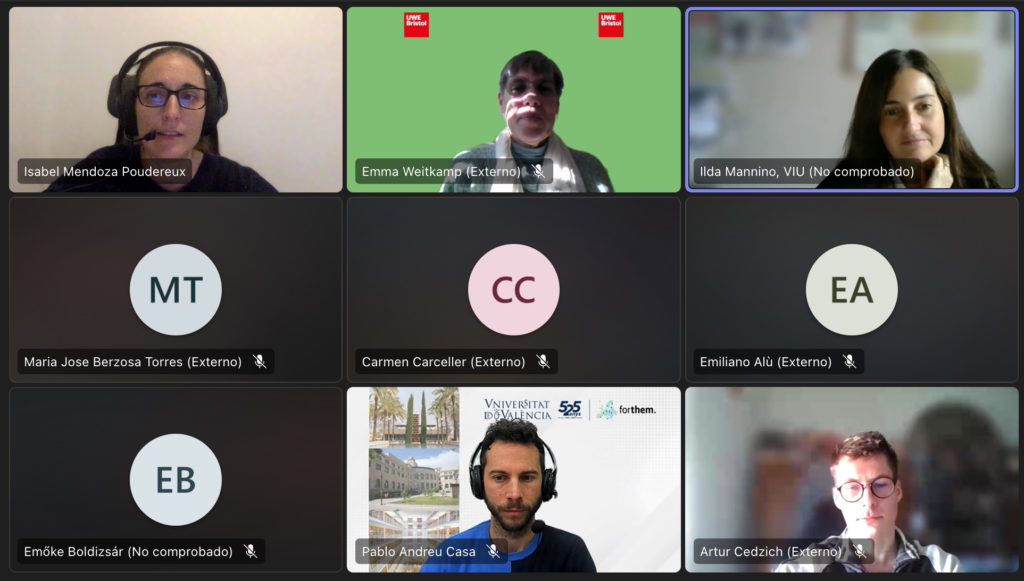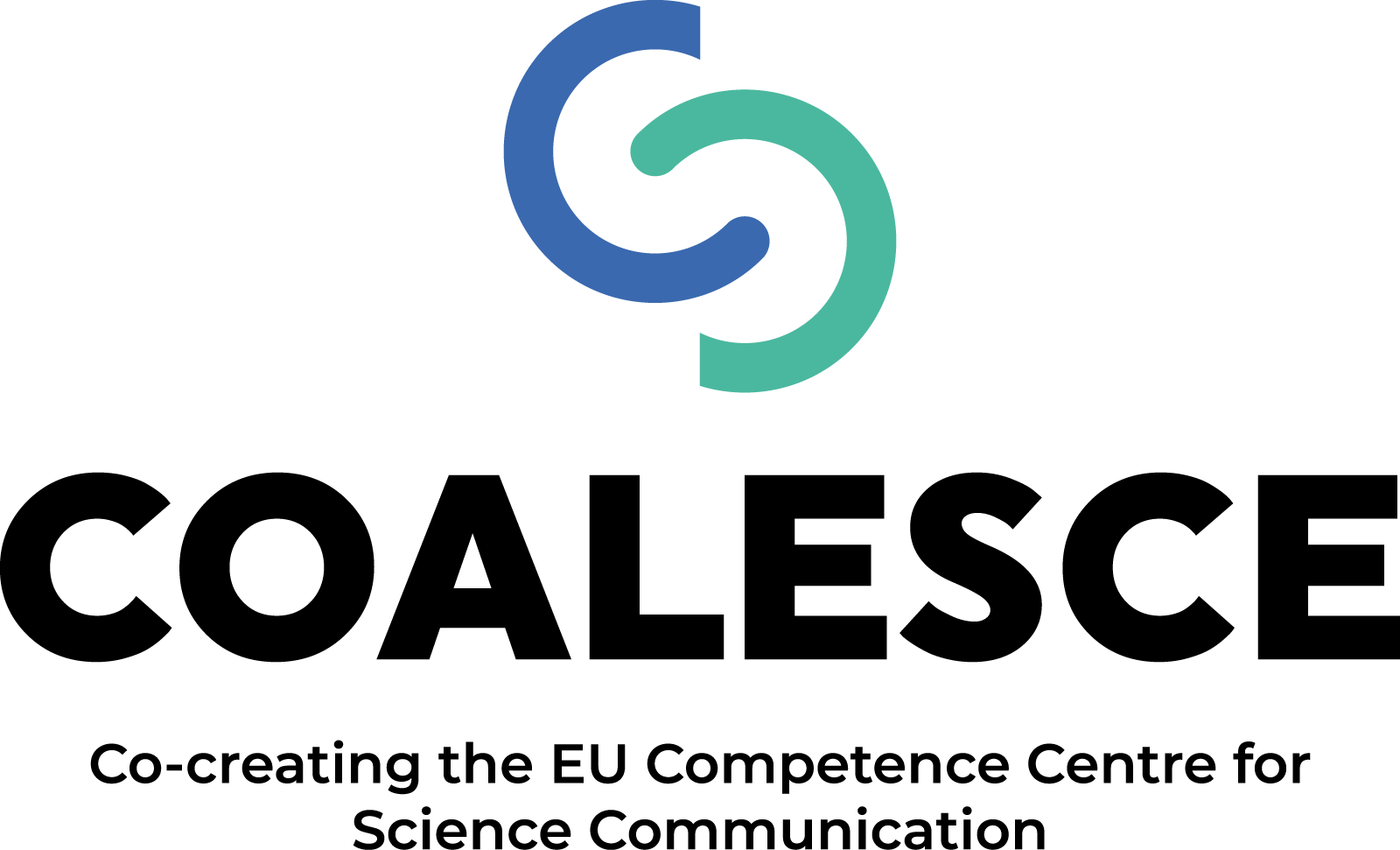Reflections on the First FORTHEM-COALESCE Webinar Experience

Isabel Mendoza (University of Valencia), Ilda Mannino (Venice International University) and Emma Weitkamp (University of the West of England Bristol) share their reflections on the first FORTHEM-COALESCE Webinar Experience.
The recently launched European Competence Centre for Science Communication is now starting to test a programme of training activities that will become part of its Academy, one of the Competence Centre most anticipated outcomes. The COALESCE team, in collaboration with relevant networks and associations, is organizing training sessions and schools, both online and in-person, to test training activities to be later offered through a rich and diverse portfolio of the Academy. Different topics, target audiences, formats and materials will constitute this first pool of testing, responding to the needs of different stakeholders gathered by COALESCE from data available from different SwafS-19 projects, interviews and focus groups (see Mannino et al., 2024). These training sessions, oriented to researchers, communication officers, science and museums staff, journalists, civil society organisations and policymakers, will continue throughout the course of the project and we are still looking for partnering opportunities.
One of the first of these, “Science and Research Communication: How to Communicate to the Public 1”, was held in cooperation with the FORTHEM University Alliance and the FORTHEM Academy for Early-Stage Researchers (A4ESR) on the 20th November 2024. The 3-hour webinar brought together early-career researchers from across Europe (and the globe!) to explore strategies for making science accessible to the public. 
Behind the Scenes
We were thrilled to see 166 registrations from participants spanning 24 countries, representing not only the 9 FORTHEM Alliance universities but also institutions such as KAIST (South Korea), the University of Edinburgh (Scotland), and Friedrich-Wilhelms-Universität Bonn (Germany). The diversity of attendees’ profiles, 69% PhD students, 13% Post-Docs, 7% Master’s students, and 11% others, was a nice surprise as well.
As organizers, we were aware of the stakes. Science communication is a no easy task, and equipping so many participants at once with basic tools demanded a thoughtfully designed program for 3-hours of training, as well as experienced presenters, and an interactive and robust platform (MS Teams along with Mentimeter) that could allow students to participate actively in real time.
The D-Day
At 10:00 CET, we kicked off. The program, structured to balance theory and practice, included the following sections and lectures:
- Welcome & Introduction to COALESCE – Isabel Mendoza, researcher from the University of Valencia, set the tone for the day, diving with participants into COALESCE’s work and the importance of science communication.
- Understanding the Researcher’s Role in Public Engagement – Ilda Mannino, researcher at Venice International University, emphasized the researcher’s role as a communicator and bridge-builder between science and society.
- From Theory to Practice: Understanding Audiences – Emma Weitkamp, professor at University of the West of England Bristol, delivered key insights on tailoring messages for diverse audiences.
- TIPS for Quality SciComm – A collaborative session where Ilda Mannino, Emma Weitkamp, and Isabel Mendoza shared practical strategies and responded to participant questions.
Interactive elements like Mentimeter were particularly well-received, allowing for real-time participation and feedback. In the end, 70 people attended the webinar, a 42% attendance rate – an excellent response for a free session. Nevertheless, we are exploring strategies to improve pre-event engagement to sustain interest and enthusiasm. We anticipate these will increase attendance, even when training is free-of-cost and not planned to be recorded, such as this one.
Participant Feedback: What Worked Well
The feedback we received highlighted several successes. Participants appear to appreciate the practical advice, structure, and enthusiasm of the presenters:
- “The final tips shared in the last presentation were useful. Implementing Mentimeter is always appreciated.”
- “Nicely structured, good tips to follow after.”
- “The idea of ‘starting from the audience'” was excellent
- “The lecturers seemed excited about their topics and shared their insights with a positive attitude.”
Others highlighted the format and relevance of the content:
- “Very clear presentation of ideas, with relevance between each unit.”
- “Interactive elements, practical tips, and strategies” were excellent
- “I learned new and interesting things about the subject.”
Challenges and Suggestions for Improvement
While the webinar received an overall rating of 5.7/7 and a teaching score of 6.2/7, we also identified areas for improvement. Some participants expressed a desire for more concrete, hands-on content:
- “It doesn’t feel like I extended my skill set. More real-world examples of successful science communication through platforms like LinkedIn, X, or face-to-face workshops would have been helpful.”
- “Balance between theory and practice: include more case studies or practical exercises.”
Technical issues also posed challenges for a few attendees:
- “I had trouble accessing the session initially, and it was unclear how to use the Q&A tool.”
- “Perhaps I was just unlucky, but my group activity was hindered by poor participation or internet issues.”
Several participants suggested incorporating more interactive storytelling and practical examples and tools to apply science communication strategies effectively.
Looking Ahead: Lessons Learned
This first webinar was a valuable learning experience for us as organizers. Moving forward, we aim to 1) Provide pre-event engagement opportunities to sustain interest and enthusiasm, to improve attendance rate. 2) Integrate more practical exercises and real-world examples. 3) Investigate technical options to ensure seamless access for participants. And 4) Enhance interactive elements such as storytelling exercises, group activities, and expanded use of interactive tools, such as Mentimeter.
We are proud of this first step and look forward to refining future sessions with the help of the FORTHEM University Alliance! Thank you for opening your community of young researchers to COALESCE!


